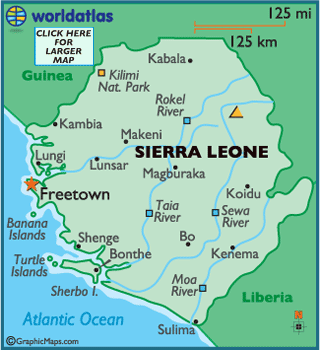(New York) - The war crimes court for Sierra Leone has handed down the first convictions by a UN-backed tribunal for the crime of recruiting and using child soldiers. Human Rights Watch said that these convictions are a ground-breaking step toward ending impunity for commanders who exploit hundreds of thousands of children as soldiers in conflicts worldwide.
In Freetown today, the Special Court for Sierra Leone handed down verdicts against three accused men from the rebel Armed Forces Revolutionary Council (AFRC), one of three warring factions during Sierra Leone’s 11-year brutal armed conflict, which ended in 2002. The judges found the three accused – Alex Tamba Brima, Brima Bazzy Kamara and Santigie Borbor Kanu – guilty of war crimes, crimes against humanity, and other serious violations of international humanitarian law, including the recruitment and use of child soldiers.
“This use of child soldiers is a particularly horrific crime. These children should have been learning how to read, not how to shoot an AK-47,” said Jo Becker, children’s rights advocate for Human Rights Watch. “We hope that the Special Court’s decision will protect children in other parts of the world from suffering what so many Sierra Leonean children were forced to endure.”
Thousands of children were recruited and used by all sides during Sierra Leone’s conflict, including the Revolutionary United Front (RUF), the AFRC, and the pro-government Civil Defense Forces (CDF). Children were often forcibly recruited, given drugs and used to commit atrocities. Thousands of girls were also recruited as soldiers and often subjected to sexual exploitation.
The Special Court for Sierra Leone was established in 2002 to prosecute those “who bear the greatest responsibility” for war crimes, crimes against humanity and other serious violations of international humanitarian law, along with several domestic offenses, committed since 1996. All nine defendants being prosecuted by the Special Court have been charged with the recruitment and use of child soldiers. The trial phase is complete for cases involving individuals associated with the CDF and AFRC. For accused associated with the RUF, the defense began presentation of its case this May. The Special Court began the trial of former Liberian president Charles Taylor on June 4 in The Hague.
“Commanders in many conflicts deliberately prey upon children as recruits,” said Becker. “Now that child recruiters are being brought to justice, their impunity is no longer so certain.”
The Special Court’s Appeals Chamber also issued a significant ruling in 2004 that the prohibition on the recruitment or use of children under the age of 15 had crystallized as customary international law prior to 1996, and that individuals bore criminal responsibility for such acts.
The first individual being tried by the International Criminal Court (ICC), the former militia leader Thomas Lubanga from the Democratic Republic of Congo, has also been charged with the crimes of enlisting and conscripting children as soldiers and using them to participate actively in hostilities. In March 2006, Lubanga was transferred to the ICC in The Hague.
Source: Human Rights Watch (http://www.hrw.org/news/2007/06/20/sierra-leone-landmark-convictions-use-child-soldiers)











